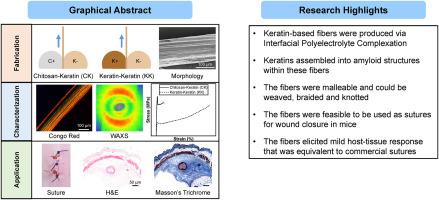Development of keratin-based fibers fabricated by interfacial polyelectrolyte complexation for suture applications
IF 12.8
1区 医学
Q1 ENGINEERING, BIOMEDICAL
引用次数: 0
Abstract
Interfacial Polyelectrolyte Complexation (IPC) is a convenient way to produce composite, micro-scale fibers. In this paper, we report the successful development of novel keratin-based IPC fibers and also demonstrate the feasibility of using these fibers as sutures through a proof-of-concept in vivo study. Two composite fibers were produced: chitosan-keratin (CK) and keratin-keratin (KK). These fibers were evaluated for their physico-chemical, mechanical and biochemical properties. In the dry state, the CK fiber had a greater Young's modulus of about 2 GPa while the KK fiber registered a longer strain-at-break of about 100 % due to the strain-stiffening effect. Notably, the keratins were found to assemble into amyloids within the composite fibers based on Congo red staining and Wide-Angle X-Ray Scattering. Functionally, both fibers were malleable could be weaved, braided and knotted. When used as sutures to close incisional wounds in mice over 21 days, these fibers were found to elicit minimal host tissue response and were partially degraded over the duration. Interestingly, the KK fiber evoked a lower extent of immune cell response and fibrous capsule encapsulation that was comparable to commercial, non-absorbable Dafilon® sutures. This work demonstrated the possibility of producing keratin-based IPC fibers which may find practicality as medical sutures.

利用界面聚电解质复合技术开发用于缝合的角蛋白基纤维。
界面聚电解质复合(IPC)是一种生产复合微尺度纤维的便捷方法。在本文中,我们报告了基于角蛋白的新型 IPC 纤维的成功开发,并通过一项体内概念验证研究证明了将这些纤维用作缝合线的可行性。我们生产了两种复合纤维:壳聚糖-角蛋白(CK)和角蛋白-角蛋白(KK)。对这些纤维的物理化学、机械和生物化学特性进行了评估。在干燥状态下,CK 纤维的杨氏模量更大,约为 2 GPa,而 KK 纤维由于应变加固效应,断裂应变更长,约为 100%。值得注意的是,根据刚果红染色和广角 X 射线散射法,发现角蛋白在复合纤维内组装成淀粉样。在功能上,这两种纤维都具有延展性,可以编织、编结和打结。当用作缝合线缝合小鼠的切口超过 21 天时,发现这些纤维引起的宿主组织反应极小,并在持续时间内部分降解。有趣的是,KK 纤维引起的免疫细胞反应和纤维囊包裹程度较低,与商用非吸收性 Dafilon® 缝合线相当。这项工作证明了生产基于角蛋白的 IPC 纤维的可能性,这种纤维可作为医用缝合线使用。
本文章由计算机程序翻译,如有差异,请以英文原文为准。
求助全文
约1分钟内获得全文
求助全文
来源期刊

Biomaterials
工程技术-材料科学:生物材料
CiteScore
26.00
自引率
2.90%
发文量
565
审稿时长
46 days
期刊介绍:
Biomaterials is an international journal covering the science and clinical application of biomaterials. A biomaterial is now defined as a substance that has been engineered to take a form which, alone or as part of a complex system, is used to direct, by control of interactions with components of living systems, the course of any therapeutic or diagnostic procedure. It is the aim of the journal to provide a peer-reviewed forum for the publication of original papers and authoritative review and opinion papers dealing with the most important issues facing the use of biomaterials in clinical practice. The scope of the journal covers the wide range of physical, biological and chemical sciences that underpin the design of biomaterials and the clinical disciplines in which they are used. These sciences include polymer synthesis and characterization, drug and gene vector design, the biology of the host response, immunology and toxicology and self assembly at the nanoscale. Clinical applications include the therapies of medical technology and regenerative medicine in all clinical disciplines, and diagnostic systems that reply on innovative contrast and sensing agents. The journal is relevant to areas such as cancer diagnosis and therapy, implantable devices, drug delivery systems, gene vectors, bionanotechnology and tissue engineering.
 求助内容:
求助内容: 应助结果提醒方式:
应助结果提醒方式:


